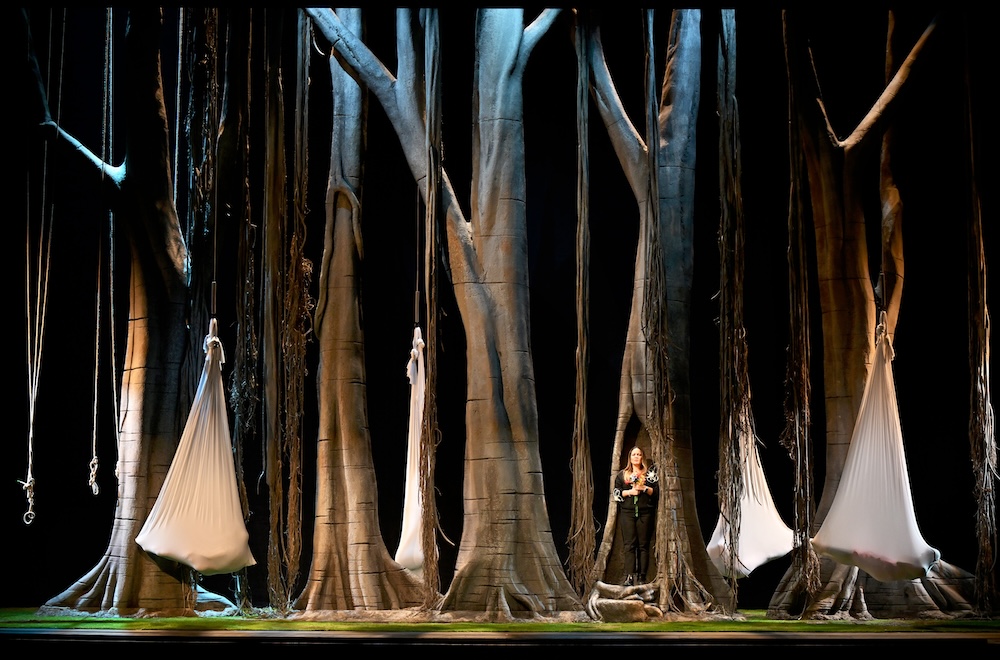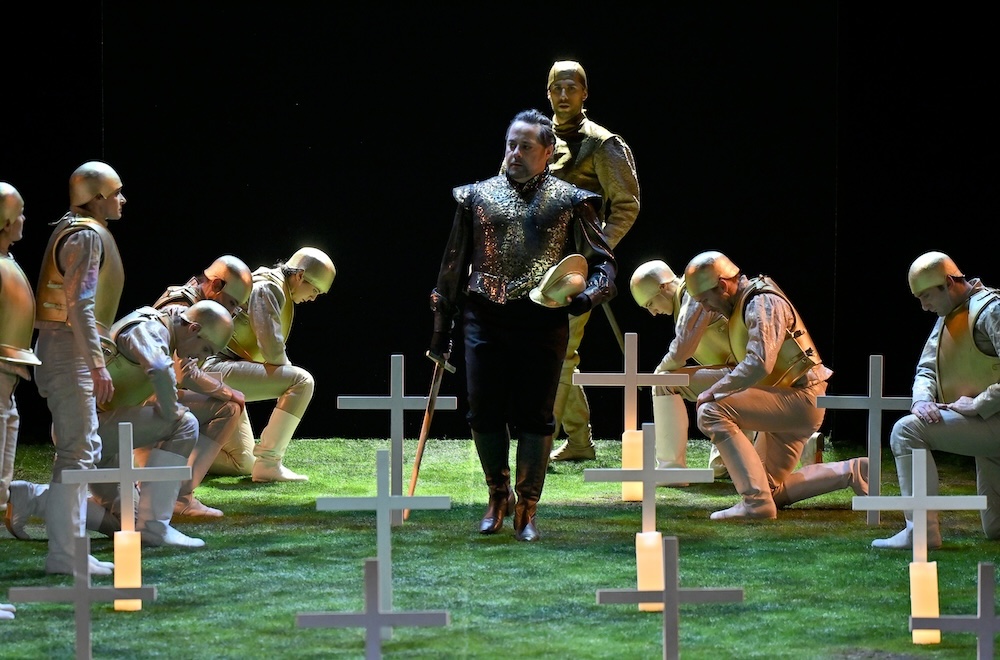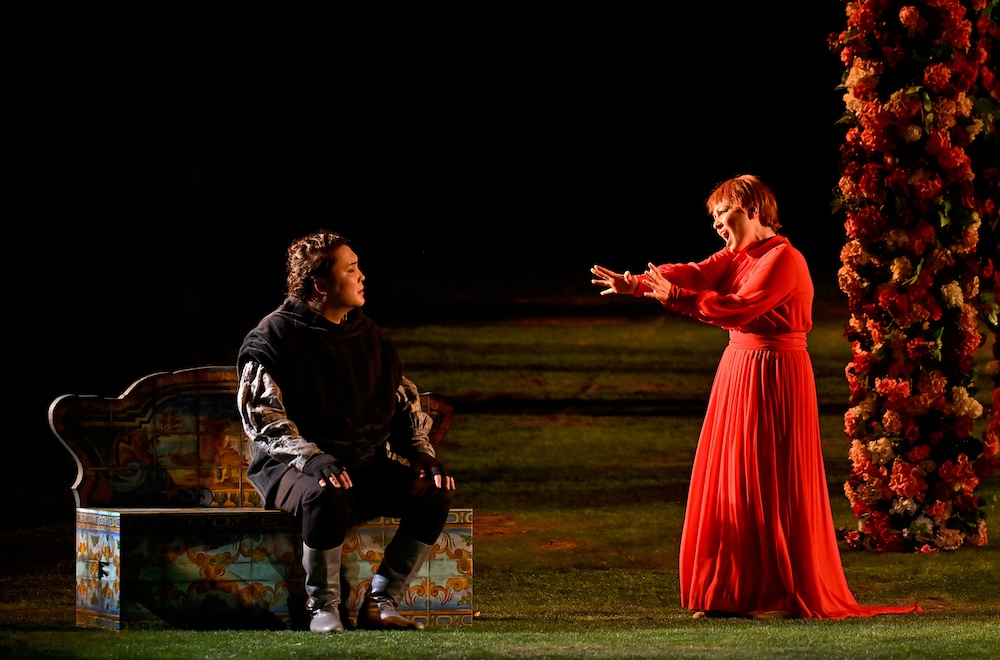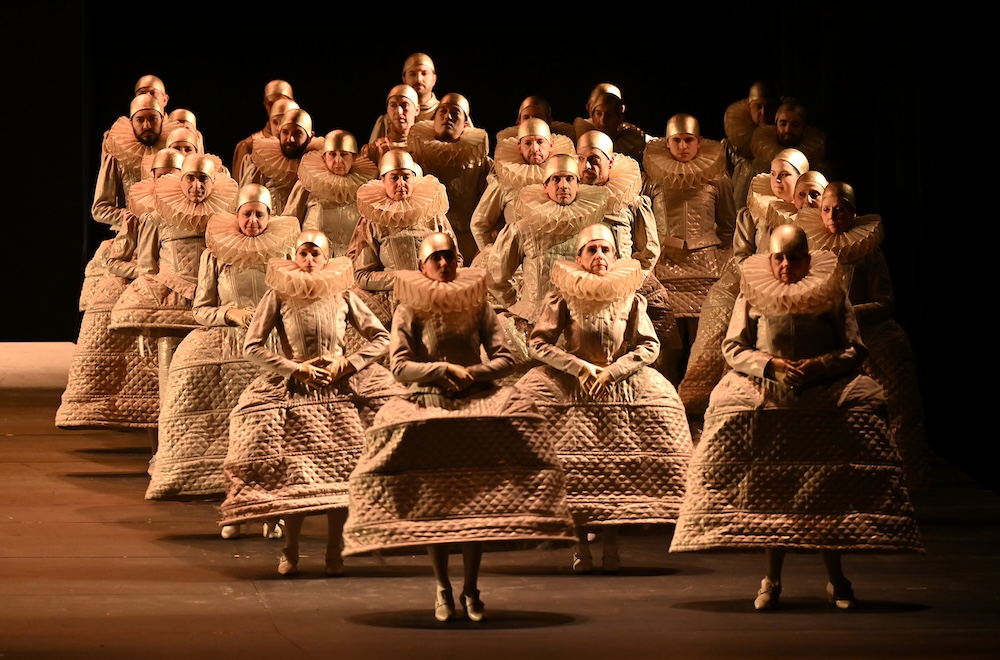The least performed of the Verdi oeuvre, not included in the Verdi canon, Giovanna d’arco (Joan of Arc) was given another chance just now on one of Italy’s famed Verdi stages, Parma’s Teatro Regio.
The Teatro Regio pulled out all the stops, engaging conductor Michele Gamba and stage director Emma Dante to work with Georgian soprano Nino Machaidze as Joan, Roman tenor Luciano Ganci as Charles VII, and Mongolian bass Ariunbaatar Ganbaatar as Joan’s father. Mme. Dante in turn worked with her longtime collaborators from Palermo, choreographer Manuela Lo Steco, set designer Carmine Maringola, and costume designer Vanessa Sannino.
It was a spectacular evening.
After his initial successes at La Scala with Nabucco and I Lombardi alla prima Crociata (later revised for Paris as Jérusalem) Verdi wished to expand his horizons, though he still owed Scala an opera. Plus he needed money to buy the land where he would eventually build Villa Verdi. Putting his Scala obligation on hold he composed Ernani (1844) for Venice and I due Foscari (1844) for Rome, before squeezing in his Milan obligation on the way back from Rome. Giovanna d’Arco premiered in February of 1845. Its lack of success succeeded in breaking Verdi’s ties with La Scala, where he did finally return, but 24 years later!
Surprisingly, Giovanna d’Arco suffered only slightly at the hands of the Milan censors, though it was heavily censored in Rome, Naples and Palermo where it became Orietta di Lesbo!
Giovanna d’Arco is an opera seria, a genre piece, pure and simple. As a “numbers” opera, Its arias, duets and a couple of trios are always interrupted by a chorus, then continued with a cabaletta. The libretto is a distant rehash of the famed Schiller play wherein she is not burned at the stake but dies on the battlefield, her reputation restored, and like the Schiller play Joan is accused by her father. Unlike Schiller she falls in love with the French king, not an English knight.
It is an insipid libretto that does not ask for spectacle, that offers no violent contrasts or emphases that might have challenged the young Verdi. The libretto does offer scenes of great intimacy, which in Parma just now left the voices absolutely naked for such expositions, in fact Verdi gave the voices an extended a cappella trio in the first act!

Soprano Nino Machaidze made a spectacular 2008 Salzburg Festival debut at age 25 as Juliette in Gounod’s Roméo et Juliette. In recent years she has taken on many of the Verdi heroines as well as the sopranos of the 19th century French repertoire. While Mme. Machaidze no longer has the bloom of her young voice, she has acquired a warmth of tone and a command of style that makes her a formidable performer. She used all of her considerable resources to make this Joan a living, breathing, voiced creature. She well held the stage in her constant battles between love and duty, her love of Charles and her love for her father. Her death was a hugely felt moment.

Tenor Luciano Ganci had the onerous task of taking on the first aria — note that all of the opera’s arias are extended scenes. It was he, suddenly alone on the stage, the silver costumed French soldiers fading into a mass of background color. It earned the evenings first bravos! He too made a spectacular debut at the Salzburg Festival, its 2012 La Traviata, and since has sung many Verdi roles for the Teatro Regio’s prestigious Verdi Festival and on the world’s major stages. In Giovanna d’Arco he has to cope with defeat, humiliate himself, assume regal stature, show forgiveness and finally mourn the death of his lover. His clear voice effectively embodies the dramatic complexities of this evolved, basically bel canto hero.

Baritone Ariunbaatar Ganbaatar won Moscow’s Tchaikovsky International competition in 2015, a prize that took him to St. Petersburg’s Marinsky Theater where he mastered the famed Verdi baritone roles over the next few years. Now 37 years old, he began appearing on European stages three years ago. His darkly colored, limpid voice is strong, and quite beautiful. He projected perfect Italianate schooling in his portrayal of a father profoundly hurt and angered by his belief that Charles VII had seduced his beloved daughter. He betrays his profound love of France, he denounces his daughter as a witch well within the bel canto dictum: say-what-you-may, but say it beautifully.
Stage director Emma Dante and her collaborators stepped in to add the spectacle that is lacking in the intimacies of the Temistocle Solera libretto. And there was plenty of it. In her youth Mme. Dante founded a theater company that surely made much use of puppets. For Giovanna d’Arco she staged a later part of the overture — wounded, identically silver clad French soldiers (the English, in their turn, were in black) jerked across the stage, one by one. The identically dressed women of the chorus that opens Act II swung their bustled skirts side to side in unison. And finally there was a real puppet — the life-sized white horse animated by two mimes that carried Joan into the final battle, and stood, head bowed to the mortally wounded Joan. It was a stunning stage picture.

The overriding directorial challenge was to provide visual interest during the extended length of the numbers of the opera. This was frequently accomplished quite gracefully by the use of 13 dancers and mimes in often highly choreographed movements that personified the interior torment of Joan and her father. The scenery evolved in bold strokes, from a black void, to receding arches made of garlands, to receding gold columned arches that led to the Christian cross, signaling the social, political and moral perspective that is the Schiller underlay of this medieval myth.
The bare exposition of voice, the lengthy numbers were magisterially paced by conductor Michele Gamba. The beauty of singing and the spectacle of the staging were so persuasive that it was surprising to understand, finally, at the bows that underneath it all, binding it together had been the Verdi orchestral score. The Filarmonia Arturo Toscanini (the Teatro Regio’s orchestra) beautifully conveyed the latest inventions of Verdi’s evolving orchestrations. The solo flute, solo clarinet and solo oboe that created a trio of instruments to interact with the trio of voices on the stage crowned the success of this excellent Teatro Regio Giovanna d’Arco.
Michael Milenski
Teatro Regio, Parma, Italy, January 30, 2025
All photos copyright Roberto Ricci Teatro Regio di Parma